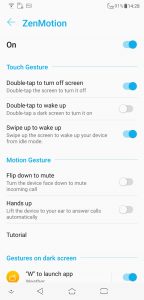Performance
The ASUS ZenFone 5 sports the mid-range Snapdragon 636 processor, 4GB of RAM and 64GB of internal storage.
Speaking in terms of the ZenFone 5's synthetic performance, it is clearly not quite as fast as some of its rivals. The Honor 10, for instance, scores over 1000 points more in the Geekbench 4 multi-core test, despite the two phones being similarly priced.
In the real world, though, the difference is not as pronounced. I did notice the occasional slowdown during my two weeks of testing, and it is not that hard anymore to max out 4GB of RAM. Still, performance is generally solid, and for £350 you can't really expect much more.
The fingerprint scanner is also decent – it is not as fast the P20 Pro or OnePlus 6, but again when we consider the price of this phone, it is just fine. There is also support for face unlocking, which has a noticeable delay of about a second before it unlocks, but it gets the job done if you want to unlock the phone hands-free.
Software
Moving onto software, the ZenFone 5 runs Android Oreo 8.0 – since I have had the device it has received one OTA update, but even then it has not yet been updated to Oreo 8.1 which is a shame. On top of that, the phone also sports ASUS' ZenUI 5 which is a rather colourful skin.
It is probably about as far from stock Android as you can get – but that is not to say it doesn't have any useful features. One of these is called ZenMotion, which lets you open various apps and control the phone through touches and gestures. You have the usual ‘double tap to wake' functionality, as well as the option to lift the phone up to answer incoming calls, but my favourite feature is the ability to ‘draw' on the screen with your finger when the phone is locked.
All you need to do is trace a letter on the screen – the software gives up to six different letters you can use – and then it will open whichever app you have programmed to that letter. For instance, draw a ‘c' and the camera app will open, or draw a ‘w' to open the weather app. Each letter can open any app of your choice, too, so it is a pretty nifty way to get into apps quickly.
There are also a few ‘AI' features baked in. One is called ‘smart screen' which will prevent the phone from automatically turning off the screen if it detects your face looking at the phone – from my testing, it seems to work just fine. There's also ‘AI charging' which supposedly learns when you charge the phone, and slows down the charge time accordingly to prevent excess strain on the battery – similar to Qnovo's tech. This isn't something you can test over a short period of time, but it should help in the long run.
One thing I'm not so keen on is the implementation of the notification icons. This is thanks to the larger-than-usual notch, meaning you can only fit two different notification icons on the status bar – a ‘…' icon will appear to let you know more notifications are there, but you won't know what they are without swiping down to open up the full notification panel. It can be quite frustrating if you're trying to multi-task.
Still, the software as a whole is fine – there is a fair bit of additional functionality baked into ZenUI 5, and while some may not find the bright colours and playful icons overly appealing, it doesn't pose any major problems for the user, so you will be able to get around the ZenFone 5 just fine.
 KitGuru KitGuru.net – Tech News | Hardware News | Hardware Reviews | IOS | Mobile | Gaming | Graphics Cards
KitGuru KitGuru.net – Tech News | Hardware News | Hardware Reviews | IOS | Mobile | Gaming | Graphics Cards














